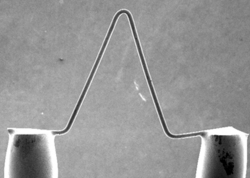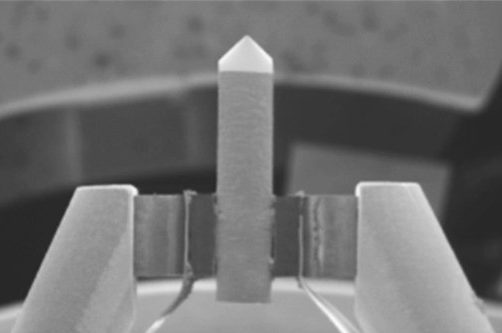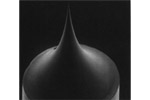The electron source is one of the most important components of an SEM and is a major determining factor in its maximum performance. There are three common electron sources found in scanning electron microscopes.
Tungsten filament
The tungsten hairpin was the original source used for the first generation of electron microscopes. It remains the most common source used today, especially among lower-cost SEMs. Tungsten sources are relatively cheap, and are designed to be replaced quickly and easily during regular usage of the SEM.
While they are the lowest cost option, tungsten emitters also provide the least performance compared to the other electron sources. The theoretical resolution of tungsten hairpins is worse than LaB6crystals or FEGs due to the significantly larger emission area of the hairpin. Tungsten sources can also be difficult to use for novice users. They must operate at white-hot temperature, around 2800K, but are exposed to ambient conditions during sample exchange. This thermal cycling causes two problems: It creates constant drift of the beam stigmation that must be manually corrected by users. And it causes the tungsten source to burn out suddenly during operation, necessitating the user to shut down the system, replace the source, re-align the new one, then restart the previous analysis.

LaB6/ CeB6crystal
这些来源utilize a highly polished crystal of lanthanum hexaboride or cerium hexaboride. The crystals produce ~10x more electrons than a tungsten filament. These crystal sources are significantly more stable than a tungsten wire, and always remain warm and under vacuum, so they require much less tuning and last for much longer. Crystal sources only require stigmation adjustments every few months, rather than the continuous focus-stigmate-focus adjustments common with tungsten-based and FEG-based SEMs.
While both materials provide similar results, the newer CeB6sources have become more common in recent years thanks to their better resistance to fouling and thereby better longevity. Thanks to all of these properties, systems powered by CeB6sources tend to be the easiest to use for non-expert users.

Field emission gun
The field emission gun (FEG) is the most powerful source available, and field emission SEMs (FE-SEMs) are found in labs that require the highest performance and best resolution possible.
Field emission guns provide excellent resolution to see smaller features, higher brightness to get crisper images with higher contrast, and better performance at low accelerating voltage to reduce imaging artifacts.
That high performance comes at a cost. FE-SEMs are generally the most expensive instruments both for initial purchase and for maintenance/upkeep costs. This is due to the high cost of the FEG itself, as well as the increased cost incurred by the source’s requirement to be run at ultra-high vacuum conditions.
Most field emission systems are full-size SEMs, but there are some automated SEMs powered by FEG sources, and there is even a desktop FE-SEMs — thePhenom Pharos.

Approximate Source Specifications
| Specs // Source Type | Tungsten Hairpin | LaB6/ CeB6Crystal | Schottky Field Emission Gun |
|---|---|---|---|
| Brightness (A/cm2-sr) | 106 | 107 | 5 x 108 |
| Resolution @ 30 kV | 3 nm | 2 nm | 1 nm |
| Resolution @ 1 kV | 50 nm | 25 nm | 5 nm |
| Energy spread | 3 eV | 1 eV | 0.3 eV |
| Vacuum (mBar) | 10-1– 10-5 | 10-7 | 10-9 |
| Operating temperature (K) | 2,800 | 1,800 | 1,800 |
| Lifetime (hours) | 100 | 1,500 | 10,000 (always on) |
| Cost per source | $100 | $3,000 | $15,000 |
Request More Info
Nanoscience Instruments is a trusted supplier of Thermo ScientificTMSEMs in the U.S. Our dedicated sales, applications, and service staff have over200 years of combined experience in SEM.